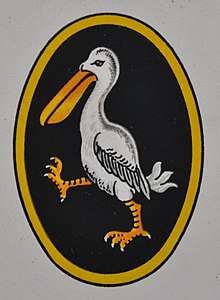62nd (2nd West Riding) Division
The 62nd (2nd West Riding) Division was an infantry division of the British Army that saw active service on the Western Front during the First World War.
| 2nd West Riding Division 62nd (2nd West Riding) Division | |
|---|---|
 Division insignia | |
| Active | 1914–1919 |
| Country | |
| Branch | |
| Type | Infantry |
| Size | Division |
| Engagements | World War I * Battle of Arras (1917) * Battle of Cambrai (1917) * Operation Michael (Somme, 1918) * Second Battle of the Marne * Second Battle of the Somme (1918) |
| Commanders | |
| Notable commanders | Walter Braithwaite |
History
During the First World War the division fought on the Western Front at Bullecourt[1] in the Battle of Arras and Havrincourt in the Battle of Cambrai. During Operation Michael, in 1918, they were in the line near Arras and in the Second Battle of the Marne, in the Ardre Valley. At the opening of Second Battle of the Somme (1918), they fought the Battle of Havrincourt and continued across the Saint Quentin Canal at Marcoing, before beginning the fighting advance to Maubeuge on the Sambre.[2]
Order of Battle
The order of battle was as follows:[3]
- 2/5th Battalion, Prince of Wales's Own (West Yorkshire Regiment) (joined March 1915, left August 1918)
- 2/6th Battalion, Prince of Wales's Own (West Yorkshire Regiment) (joined March 1915, left January 1918)
- 2/7th Battalion, Prince of Wales's Own (West Yorkshire Regiment) (joined March 1915, left June 1918)
- 2/8th Battalion, Prince of Wales's Own (West Yorkshire Regiment) (joined March 1915, left February 1918)
- 1/8th Battalion, Prince of Wales's Own (West Yorkshire Regiment) (joined January 1918)
- 1/5th (Prince of Wales's) Battalion, Devonshire Regiment (joined June 1918)
- 2/20th (County of London) Battalion, London Regiment (joined August 1918)
- 2/4th Battalion, Duke of Wellington's (West Riding Regiment) (joined March 1915)
- 2/5th Battalion, Duke of Wellington's (West Riding Regiment) (joined March 1915, left January 1918)
- 2/6th Battalion, Duke of Wellington's (West Riding Regiment) (joined March 1915, disbanded January 1918)
- 2/7th Battalion, Duke of Wellington's (West Riding Regiment) (joined March 1915, left as a cadre June 1918)
- 5th Battalion, Duke of Wellington's (West Riding Regiment) (joined January 1918)
- 2/4th Battalion, Hampshire Regiment (joined June 1918)
- 2/4th Battalion, King's Own (Yorkshire Light Infantry) (joined March 1915)
- 2/5th Battalion, King's Own (Yorkshire Light Infantry) (joined March 1915, absorbed 1/5th Bn and became simply 5th Bn February 1918)
- 2/4th Hallamshire Battalion, York and Lancaster Regiment (joined March 1915)
- 2/5th Battalion, York and Lancaster Regiment (joined March 1915, disbanded February 1918)
General Officer Commanding
- Major General Sir James Trotter February 1915 – December 1915[4]
- Major-General Walter Braithwaite December 1915 – August 1918
- Major-General Robert Whigham August 1918 – 1919
gollark: Added to your submission grappling profile.
gollark: I'm mostly intending to avoid it because the industry is apparently awful and nobody can actually make big software projects actually work.
gollark: I tried writing Haskell malware once, but unfortunately it was unable to actually do anything but maliciously non-terminate.
gollark: Various potentially lethal cognitohazards.
gollark: See, if you use Discord with foolishly rounded corners, you miss all the exciting corners of avatars.
References
- Anderson 1920, p. 15.
- Anderson 1920, p. 102.
- "62nd (2nd West Riding) Division". The Long, Long Trail. Retrieved 21 May 2020.
- Wyrall, Everard (1924). The History of the 62nd (West Riding) Division.
Bibliography
- Anderson, Austin Thomas (1920). War services of the 62nd West Riding Divisional Artillery. Cambridge: Heffer and Sons. OCLC 558510602.CS1 maint: ref=harv (link)
- Wyrall, E. (1924). The Story of the 62nd (West Riding) Division, 1914–1919. I. London: The Bodley Head. OCLC 6256569. Retrieved 4 January 2015.
- Wyrall, E. (2003) [1928]. The Story of the 62nd (West Riding) Division, 1914–1919. II (Naval & Military Press ed.). London: The Bodley Head. ISBN 1-84342-582-3.
External links
This article is issued from Wikipedia. The text is licensed under Creative Commons - Attribution - Sharealike. Additional terms may apply for the media files.